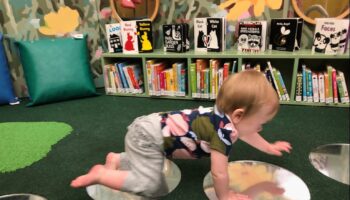Submitted by Tracy Walter
Typically, when working with teachers in the field and they mention sensory play, they think mostly of sand and water play. Although sand and water can provide a great sensory experience for children, there are many other types of sensory play that are often forgotten. We have two sensory systems that are overlooked often: our proprioceptive and vestibular systems. If you have never heard of them, you may be thinking “What in the world are those?”
The proprioception sense refers to our body’s awareness. This system helps us determine the amount of force that is needed to push, pull, lift, or even hold objects. Our vestibular sense refers to the movement and balance of the body while engaging in activities.
When considering using sensory play to help develop the two systems, you may be asking if riding a bike or listening to music would count and the answer is yes! Activities as simple as those are great sensory activities; however, there are more.
Let’s think about being outside with children. When we take young children out to the playground or the outside play area, it is important to have a variety of toys for the children to play with. When developing the space, be sure to include the toys children can ride on, push, pull, and pedal. These are all great examples of sensory play that will help develop the proprioception and vestibular systems.
When you come inside to play, providing areas that include a variety of toys with different textures, sounds, and scents are important for the development of children. Sensory play helps to build nerve connections in their brain that help children be able to complete complex tasks. Sensory play helps children develop their language, their fine motor skills, gross motor skills and cognitive growth. Sensory play is also found to have a calming effect on children. Another important aspect of development for the young child that sensory play will do is it enhances social interactions among children.
As you reflect on your classroom, simple ways to incorporate sensory play are things such as water, sand, craft pom-poms, cotton balls, Easter grass, packing peanuts, and buttons. These are just some examples that you may want to consider. Most importantly, consider the age of the children in your classroom, and be sure to avoid materials that would pose a choking hazard. For younger children, you may want to consider larger plastic balls, larger foam shapes, sensory bottles, and empty tissue boxes stuffed with soft fabric of different textures for the children to pull out.
Think outside the box to make sensory play exciting and new for children and think about the five senses as you develop activities to help make it most engaging for the children.
Resources:
https://health.clevelandclinic.org/benefits-of-sensory-play-ideas/
Vestibular vs. Proprioceptive Sensory Systems Explained (bigleapsct.com)




